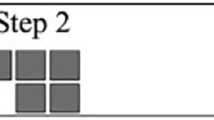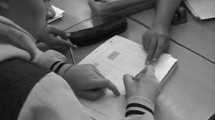Abstract
The purpose of this study is to investigate the quality of class talk during episodes corresponding to different levels of generalization. A total of 10 sessions in two classrooms in grade 7 were videotaped. A mixed approach was adopted to analyze the videotaped sessions. The findings show that triadic dialog was the dominant mode of interaction during class talk. The teacher’s general teaching approach was inductive with a tendency to dialogic teaching, although there were some indicators to univocal class talk. This tendency to use dialogic teaching was due to shifts between generalization level episodes (at a macro level) and among knowledge types within episodes (at a micro level), which influenced the quality of class talk. Besides, the teacher played the role of secondary knower, thus allowing dialogic discourse during class talk. Furthermore, in almost all episodes, it was the teacher who initiated the episodes, and he frequently started the majority of exchanges. Triadic dialog in class talk and the multiplicity of teacher’s roles, as initiator and secondary knower, helped to elicit various levels of generalization.







Similar content being viewed by others
References
Alexander, R. J. (2000). Culture and pedagogy: International comparisons in primary education. Oxford, England: Blackwell.
Amin, T., & Badreddine, D. (2019). Teaching science in Arabic: Diglossia and discourse patterns in the elementary classroom. International Journal of Science Education. https://doi.org/10.1080/09500693.2019.1629039.
Bakhtin, M. M. (1981). The dialogic imagination: Four essays by MM Bakhtin. Austin, TX: University of Texas Press.
Barwell, R. (2016). Formal and informal mathematical discourses: Bakhtin and Vygotsky, dialogue and dialectic. Educational Studies in Mathematics, 92(3), 331–345.
Barwell, R. (2018). From language as a resource to sources of meaning in multilingual mathematics classrooms. The Journal of Mathematical Behavior, 50, 155–168.
BouJaoude, S. B., & Jurdak, M. E. (2010). Integrating physics and math through microcomputer-based laboratories (MBL): Effects on discourse type, quality, and mathematization. International Journal of Science and Mathematics Education, 8(6), 1019–1047.
Dörfler, W. (1991). Meaning: Image schemata and protocols. In F. Furinghetti (Ed.), Proceedings of the 15th International Conference for the Psychology of Mathematics Education (Vol. 1, pp. 17–32). Assisi, Italy: PME.
El Mouhayar, R. (2018). Trends of progression of student level of reasoning and generalization in numerical and figural reasoning approaches in pattern generalization. Educational Studies in Mathematics, 99(1), 89–107.
El Mouhayar, R. (2019a). Triadic dialogue during classroom talk in the context of pattern generalization. In M. Graven, H. Venkat, A. Essien & P. Vale (Eds.), Proceedings of the 43rd Conference of the International Group for the Psychology of Mathematics Education (Vol. 2, pp. 224–231). Pretoria, South Africa: PME.
El Mouhayar, R. (2019b). Exploring teachers’ attention to students’ responses in pattern generalization tasks. Journal of Mathematics Teacher Education, 22(6), 575–605.
El Mouhayar, R., & Jurdak, M. (2013). Teachers' ability to identify and explain students' actions in near and far figural pattern generalization tasks. Educational Studies in Mathematics, 82(3), 379–396. https://doi.org/10.1007/s10649-012-9434-6.
El Mouhayar, R. & Jurdak, M. (2015). Variation in strategy use across grade level by pattern generalization types. International Journal of Mathematical Education in Science and Technology, 46(4), 553–569. https://doi.org/10.1080/0020739X.2014.985272.
El Mouhayar, R., & Jurdak, M. (2016). Variation of student numerical and figural reasoning approaches by pattern generalization type, strategy use and grade level. International Journal of Mathematical Education in Science and Technology, 47(2), 197–215. https://doi.org/10.1080/0020739X.2015.1068391.
Jurdak, M. & El Mouhayar, R. (2014). Trends in the development of student level of reasoning in pattern generalization tasks across grade-level. Educational Studies in Mathematics, 85(1), 75–92. https://doi.org/10.1007/s10649-013-9494-2.
Kazemi, E., & Stipek, D. (2009). Promoting conceptual thinking in four upper-elementary mathematics classrooms. Journal of Education, 189(1–2), 123–137.
Kieran, C. (1996). The changing face of school algebra. In C. Alsina, J. M. Alvarez, B. Hodgson, C. Laborde & A. Perez (Eds.), 8th International Congress on Mathematical Education: Selected lectures (pp. 271–290). Sevilla, Spain: S.A.E.M. Thales.
Kieran, C. (2004). Algebraic thinking in the early grades: What is it? The Mathematics Educator, 8(1), 139–151.
Krathwohl, D. R. (2002). A revision of Bloom’s taxonomy: An overview. Theory Into Practice, 41(4), 212–218.
Lemke, J. L. (1990). Talking science: Language, learning, and values. Norwood, NJ: Ablex.
Mehan, H. (1979). “What time is it, Denise?”: Asking known information questions in classroom discourse. Theory Into Practice, 18(4), 285–294.
Mercer, N. (1995). The guided construction of knowledge: Talk amongst teachers and learners. Clevedon, England: Multilingual Matters Ltd.
Mercer, N., & Sams, C. (2006). Teaching children how to use language to solve math problems. Language and Education, 20(6), 507–528.
Mortimer, E. F., & Scott, P. H. (2003). Meaning making in secondary science classrooms. Buckingham, England: Open University Press.
Nassaji, H., & Wells, G. (2000). What’s the use of triadic dialogue? An investigation of teacher-student interaction. Applied Linguistics, 21(3), 376–406.
Nassbaum, M. C. (1990). Love’s knowledge: Essays on philosophy and literature. Oxford: Oxford University Press.
National Council of Teachers of Mathematics (NCTM). (2000). Principles and standards for school mathematics. Reston, VA: NCTM.
Patton, M. Q. (2002). Qualitative research and evaluation methods (3rd ed.). Thousand Oaks, CA: Sage.
Phakeng, M. S. (2016). Mathematics education and language diversity: Mathematics education and language diversity. In A. Halai & P. Clarkson (Eds.), Teaching and learning mathematics in multilingual classrooms (pp. 11–23). Rotterdam, The Netherlands: Sense Publishers.
Radford, L. (2002). The seen, the spoken and the written: A semiotic approach to the problem of objectification of mathematical knowledge. For the Learning of Mathematics, 22(2), 14–23.
Radford, L. (2003). Gestures, speech, and the sprouting of signs: A semiotic-cultural approach to students’ types of generalization. Mathematical Thinking and Learning, 5(1), 37–70.
Radford, L. (2006). Algebraic thinking and the generalization of patterns: A semiotic perspective. In S. Alatorre, J. L. Cortina, M. Sáiz, & A. Méndez (Eds), Proceedings of the 28th Conference of the International Group for the Psychology of Mathematics Education, North American Chapter (Vol. 1, pp. 2–21). Mérida, Mexico: Universidad Pedagógica Nacional.
Radford, L. (2008). Iconicity and contraction: A semiotic investigation of forms of algebraic generalizations of patterns in different contexts. ZDM, 40(1), 83–96.
Radford, L. (2010a). Algebraic thinking from a cultural semiotic perspective. Research in Mathematics Education, 12(1), 1–19.
Radford, L. (2010b). Layers of generality and types of generalization in pattern activities. PNA. Revista de Investigación en Didáctica de la Matemática, 4(2), 37–62.
Radford, L., Bardini, C., & Sabena, C. (2007). Perceiving the general: The multisemiotic dimension of students’ algebraic activity. Journal for Research in Mathematics Education, 38(5), 507–530.
Rivera, F. D., & Becker, J. R. (2008). Middle school children’s cognitive perceptions of constructive and deconstructive generalizations involving linear figural patterns. ZDM, 40(1), 65–82.
Ruthven, K., Hofmann, R., & Mercer, N. (2011). A dialogic approach to plenary problem synthesis. In B. Ubuz (Ed.), Proceedings of the 35th Conference of the International Group for the Psychology of Mathematics Education (Vol. 4, pp. 81-88). Ankara, Turkey: PME.
Salloum, S., & BouJaoude, S. (2019). The use of triadic dialogue in the science classroom: A teacher negotiating conceptual learning with teaching to the test. Research in Science Education, 49(3), 829–857. https://doi.org/10.1007/s11165-017-9640-4.
Shulman, L. S. (2007). Practical wisdom in the service of professional practice. Educational Researcher, 36(9), 560–563.
Siegler, R. S. (2000). The rebirth of children’s learning. Child Development, 71(1), 26–35.
Stacey, K. (1989). Finding and using patterns in linear generalising problems. Educational Studies in Mathematics, 20, 147–164.
Stake, R. E. (1995). The art of case study research. Thousand Oaks, CA: Sage.
Truxaw, M. P., & DeFranco, T. (2008). Mapping mathematics classroom discourse and its implications for models of teaching. Journal for Research in Mathematics Education, 39(5), 489–525.
Truxaw, M. P., & DeFranco, T. C. (2009). Orchestrating whole group discourse to mediate mathematical meaning. In L. Knot (Ed.), The role of mathematics discourse in producing leaders of discourse (pp. 129–151). Charlotte, NC: Information Age Publishing.
Vygotsky, L. S. (1978). Mind in society: The development of higher psychological processes. Cambridge, MA: Harvard University Press.
Wells, G. (1999). Dialogic inquiry: Toward a sociocultural practice and theory of education. New York, NY: Cambridge University Press.
Wertsch, J. V. (1991). Voices of the mind: A sociocultural approach to mediated action. Harvard University Press.
Wertsch, J. V. (1998). Mind as action. New York, NY: Oxford University Press.
Zevenbergen, R. (2001). Mathematics, social class, and linguistic capital: An analysis of mathematics classroom interactions. In B. Atweh, H. J. Forgasz, & B. Nebres (Eds.), Sociocultural research on mathematics education (pp. 201–215). Mahwah, NJ: Lawrence Erlbaum Associates.
Acknowledgments
This study is funded by AUB Funds; 14110 Office of the Provost; 11190 Education (Award Number: 102725; Project Number: 21068; grant holder R. El Mouhayar).
Author information
Authors and Affiliations
Corresponding author
Rights and permissions
About this article
Cite this article
El Mouhayar, R. Investigating Quality of Class Talk in Grade 7: the Case of Pattern Generalization. Int J of Sci and Math Educ 19, 1015–1036 (2021). https://doi.org/10.1007/s10763-020-10092-8
Received:
Accepted:
Published:
Issue Date:
DOI: https://doi.org/10.1007/s10763-020-10092-8




